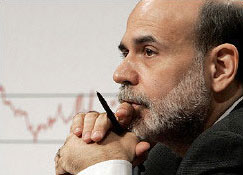 In remarks to the Economic Club of New York on the outlook for the economy and Fed policy, Fed Chairman Ben Bernanke on Monday said the central bank will keep a close eye on the sliding U.S. dollar. “We are attentive to the implications of changes in the value of the dollar and will continue to formulate policy to guard against risks to our dual mandate to foster both maximum employment and price stability. Our commitment to our dual objectives, together with the underlying strengths of the U.S. economy, will help ensure that the dollar is strong and a source of global financial stability.” Bernanke said.
In remarks to the Economic Club of New York on the outlook for the economy and Fed policy, Fed Chairman Ben Bernanke on Monday said the central bank will keep a close eye on the sliding U.S. dollar. “We are attentive to the implications of changes in the value of the dollar and will continue to formulate policy to guard against risks to our dual mandate to foster both maximum employment and price stability. Our commitment to our dual objectives, together with the underlying strengths of the U.S. economy, will help ensure that the dollar is strong and a source of global financial stability.” Bernanke said.
During his comments, the Fed Chairman emphasized that it is crucial that large financial firms be allowed to fail in order to return market discipline to the financial system.
The nation will not have a “real market-based financial system until it’s safe to let a financial firm fail,” he said.
The Fed Chief also said that bank regulators should be able to require big commercial banks to divest or limit their proprietary trading divisions if they argue that the activities are too risky. “If supervisors look at a large banking orgnaization and they determine that the company is not able to manage the risks associated with that activity or it creates other risks to safety and soundness or it doesn’t have capital to engage in the activities, the supervisor should be allowed by law to have the firm divest itself of those activities,” Bernanke said.
On the Commercial real estate topic Bernanke said that the fundamentals of the sector have deteriorated as the economy has weakened, leading to significant declines in property values, increased vacancy rates, and falling rents.
“These poor fundamentals have caused a sharp deterioration in the credit quality of CRE loans on banks’ books and of the loans that back commercial mortgage-backed securities (CMBS)”, Bernanke said.” Pressures may be particularly acute at smaller regional and community banks that entered the crisis with high concentrations of CRE loans. In response, banks have been reducing their exposure to these loans quite rapidly in recent months. Meanwhile, the market for securitizations backed by these loans remains all but closed. With nearly $500 billion of CRE loans scheduled to mature annually over the next few years, the performance of this sector depends critically on the ability of borrowers to refinance many of those loans. Especially if CMBS financing remains unavailable, banks will face the tough decision of whether to roll over maturing debt or to foreclose.
Recognizing the importance of this sector for the economic recovery, the Federal Reserve has extended the TALF programs for existing CMBS through March 2010 and newly structured CMBS through June. Moreover, the banking agencies recently encouraged banks to work with their creditworthy borrowers to restructure troubled CRE loans in a prudent manner, and reminded examiners that–absent other adverse factors–a loan should not be classified as impaired based solely on a decline in collateral value.”
Mr. Bernanke predicted that the recent economic pickup reflects more than purely temporary factors and that the economy should continue to grow next year, but he warned of “important headwinds” that will restrain the recovery, including a weak job market and tight credit for small businesses and households.
Those forces “likely will prevent the expansion from being as robust as we would hope,” he said.
Disclaimer: This page contains affiliate links. If you choose to make a purchase after clicking a link, we may receive a commission at no additional cost to you. Thank you for your support!


Leave a Reply